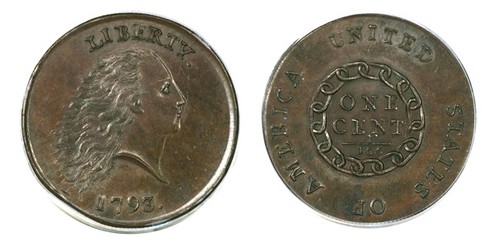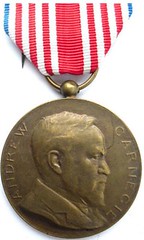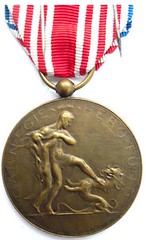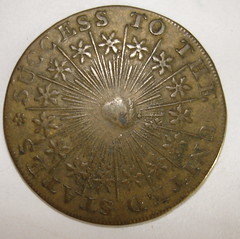
PREV ARTICLE
NEXT ARTICLE
FULL ISSUE
PREV FULL ISSUE
WAYNE'S NUMISMATIC DIARY: JANUARY 15, 2012

Last week I saw several accounts in the mainstream press about the 1793 Chain Cent which sold for $1.38 million. I even heard the story on the radio. I didn't put anything in The E-Sylum because the articles didn't really provide anything new or interesting in terms of numismatic research. But the topic came up again this week when, of all things, I was helping my son Christopher with his homework. He'd been asked to choose and discuss five articles from the news, and one he'd chosen was about the 1793 cent. Knowing the auction included a consignment from copper specialist Denis Loring, I blurted out, "I think I know the guy who sold that". We talked a bit about auctions and I told him how I'd sold a lot of items from my own collection in auctions in 2006. He asked how much my most expensive coin sold for. It wasn't a coin actually - it was a piece of Confederate paper money. But I certainly didn't have anything that hit $1 million, and neither did Denis, at least not in THIS sale. I emailed him about the coin and learned that while he had several 1793 cents in the sale, the $1.38 million one wasn't his. So much for my story. But it was nice to talk coins for a while. I told Chris about the Eliasberg collection, which was mentioned in the article.
To read one of the articles, see:
1793 penny fetches $1.38M at Fla. auction; copper coin from 1st year that US made own coins
(www.washingtonpost.com/national/1793-penny-fetches-1m
By the way, there was a great article on Denis' coins in Coin Week in December:
Coin Rarities & Related Topics: The 1793 Large Cents of Denis Loring
(www.coinweek.com/news/featured-news/coin-rarities Another item that caught my eye this week was about a numismatically-named racehorse: Although the word "tetradrachm" doesn't exactly roll off the tongue, the name for a son of Badge of Silver is actually quite apropos, because the tetradrachm was an ancient Greek silver coin that was in wide circulation from 510 to 38 B.C. and its use as a currency spread with the armies of Alexander the Great. To read the complete article, see: Tetradrachm minted as Louisiana Derby hopeful (www.brisnet.com/cgi-bin/editorial/news/article.cgi?id=26018) On Tuesday night I went to the Wildfire restaurant at the Galleria in Tyson's Corner for the month dinner of my Northern Virginia Numismatic social club Nummis Nova. For a change I was the first one there, but was quickly joined by Wayne Herndon, Joe Levine, Gene Brandenburg, Eric Schena, Mike Packard, Tom Kays, Roger Burdette, Julian Leidman and Dave Schenkman. A number of interesting numismatic items were passed around the table, including a number of British medals and a double thaler. Tom Kays had a display of new purchases, and I showed my latest addition, a medal from the Belgian Carnegie Hero Fund. Gene Brandenburg passed around a neat white medal in a small red box; Tom Kays has a write-up about this piece later in this issue.


As usual, the drinks and conversation flowed freely. Wayne Herndon told us about his experiences at F.U.N. (it was a great show). Tom Kays passed around an electronic copy of an article he's writing. Eric Schena passed around a manuscript too - this one for a long article on Virginia Ingle System Scrip that he planned to offer to the TAMS Journal. Thursday afternoon I got an email from Eric's wife Heather - he had come down with a nasty case of food poisoning and was in the hospital. At the request of his doctors I contacted everyone who'd been at the dinner, but none has gotten sick. Gene said "I did have a weird dream about mint marks but that could have been the wine." I passed along updates on his condition to members throughout the weekend. Eric's improving and feeling better, but as of tonight was still hospitalized. We all miss him and wish him a speedy and full recovery. At the dinner I picked up a book from Tom Kays - the Quarterman compilation of Numismatist articles on The Coinages of Latin America and the Caribbean. I looked thru it over the weekend and was intrigued by two articles in particular. Both were related to the Bahamas. The first, by Alvin Kress, was about the Bahama Penny of 1806-1807. As for the second one, let's see how much our readers know. QUICK QUIZ: What were the Cat Cay tokens? Who made them and what was pictured on them? When was the last year they were used? Extra credit goes to anyone who can say they've actually been to the place where they were issued. Earlier in the week I looked at a Washington Success token on eBay. The seller, Lloyd Wagner, had contacted me asking if I could identify the variety. I couldn't, and with the auction deadline of Saturday the timing wouldn't work to put a question in The E-Sylum. I told him I'd consider bidding on it and exchanged some email privately with Ray Williams. Ray noted that although the lot description says these are "Presumed to have been struck around Washington's second inauguration in 1793", the "Success Tokens are currently believed to be a product made in the mid-1800s". In the end I didn't bid and wouldn't have gotten it anyway - it was out of my range. Lloyd reported that "after some fierce bidding, the Washington Success token sold for $1036.58!" What's up with that? Is it a rare variety? Neither of us thought it would bring anywhere near that.


To view the complete lot description, see
Rare 1793 George Washington SUCCESS TO THE UNITED STATES Token
(http://www.ebay.com/itm/220927904998)
The Numismatic Bibliomania Society is a non-profit organization promoting numismatic literature. See our web site at coinbooks.org. To submit items for publication in The E-Sylum, write to the Editor at this address: whomren@gmail.com To subscribe go to: https://my.binhost.com/lists/listinfo/esylum All Rights Reserved. NBS Home Page Contact the NBS webmaster 
|